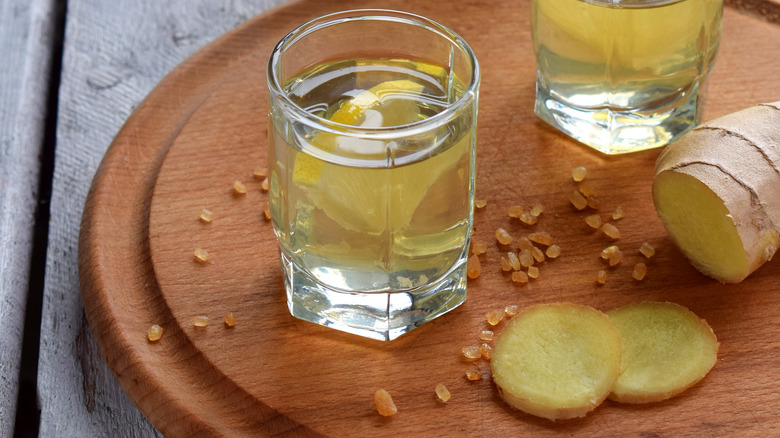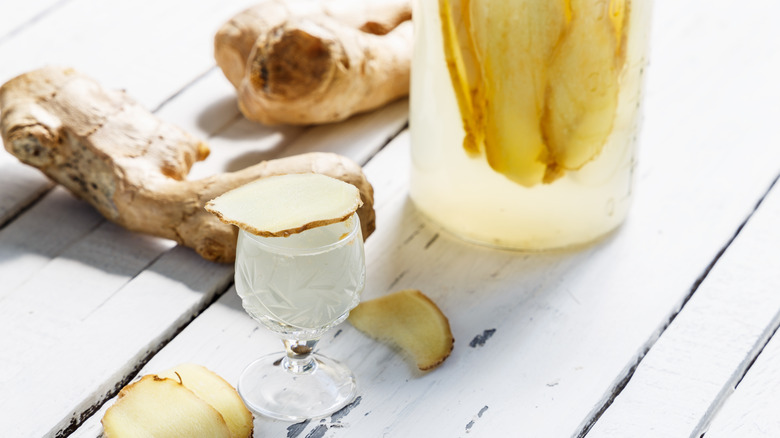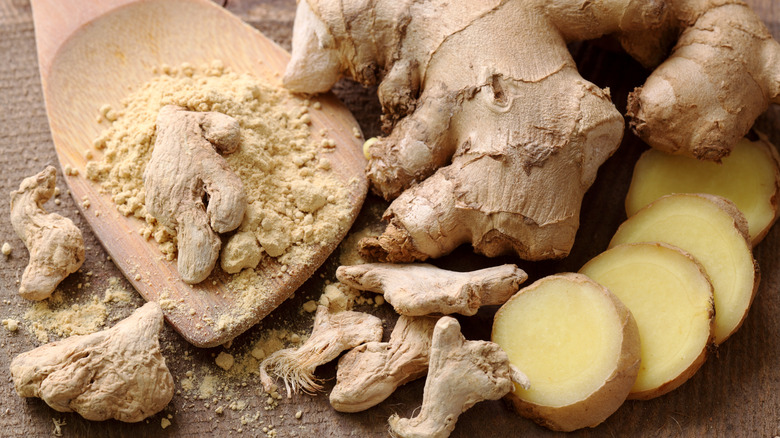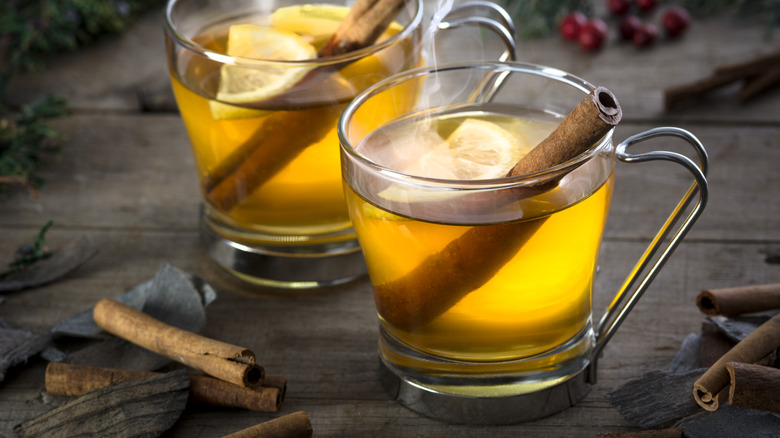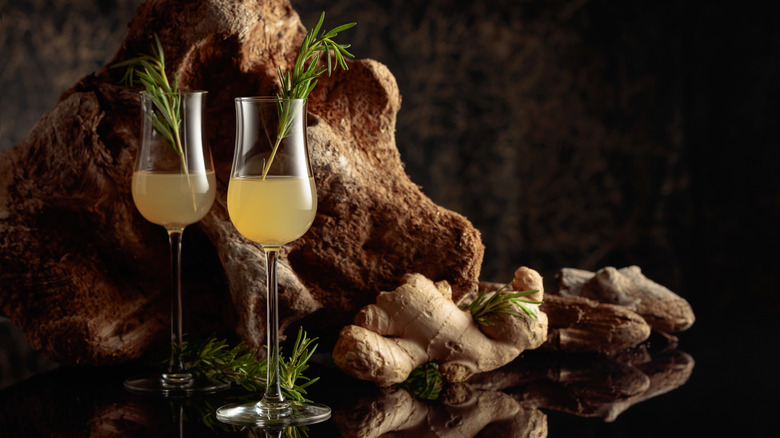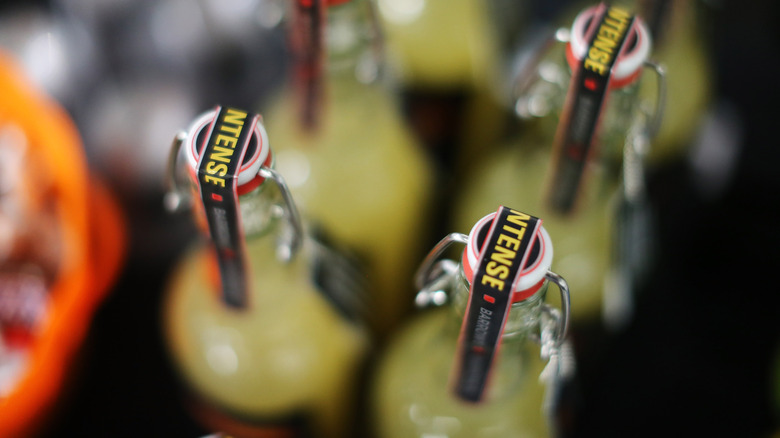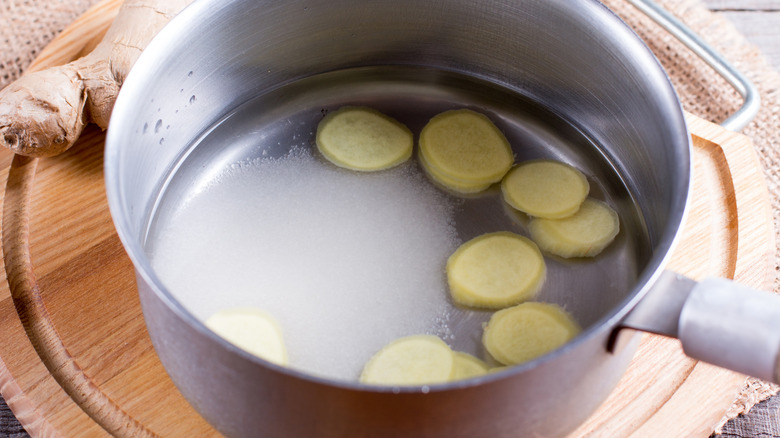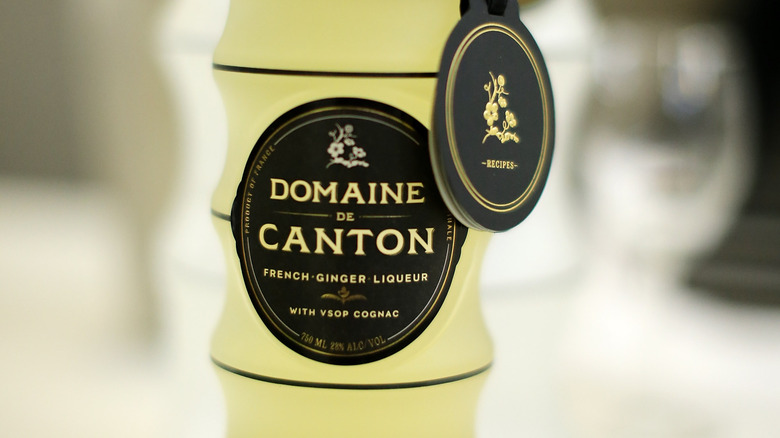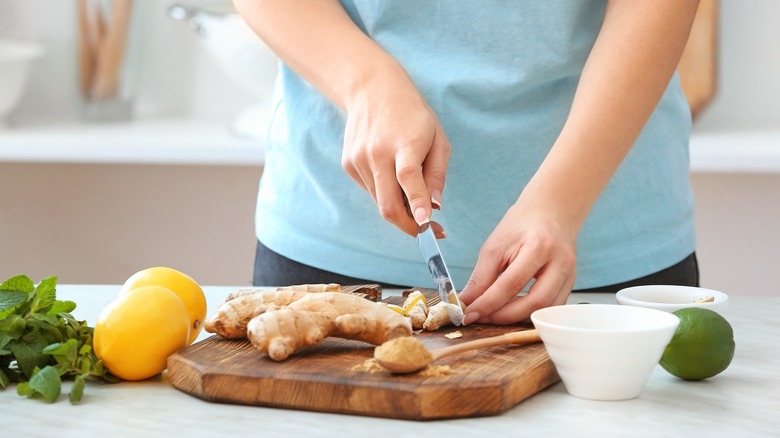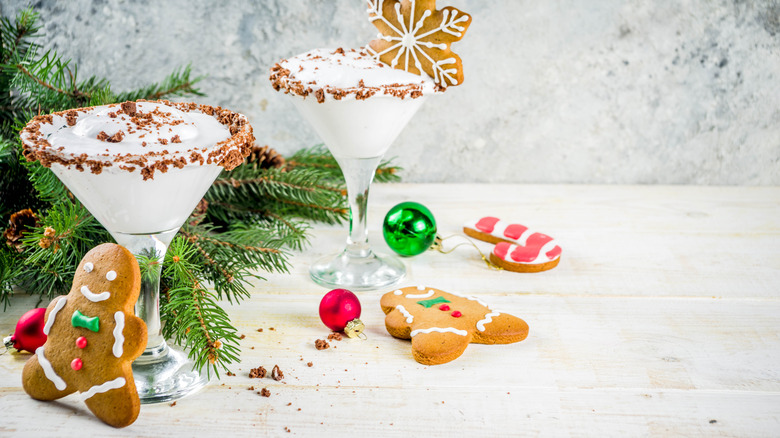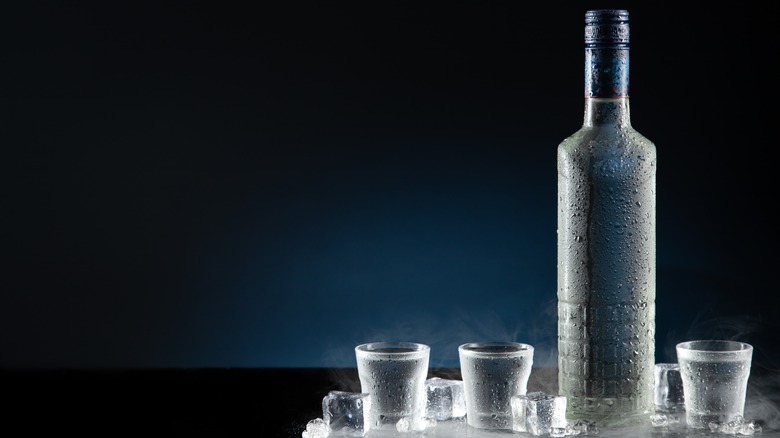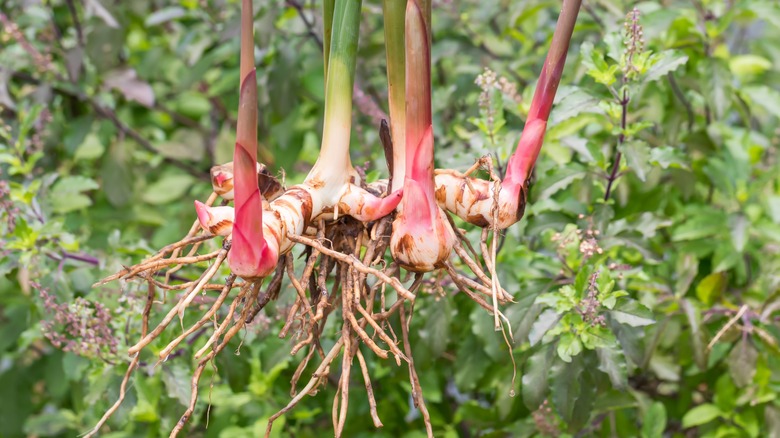Should You Buy Or Make Your Own Ginger Liqueur?
Humming for a tasty alcoholic drink to keep you warm during these chilly months? Ginger liqueur is the boozy beverage you've been searching for. Like other liqueurs, ginger liqueur is made from distilled spirits infused with herbs and spices and often sweetened with sugar (via MasterClass). This sweet, low-proof liqueur has been a popular drink since the 13th century when Italians used it for medicinal purposes (via Caskers).
Ginger liqueur itself has a history rooted in health. What's believed to be the original brand, King's Ginger Liqueur, was developed to keep the jolly ol' king warm during the unending, brutal winters in the British Isles, notes Food For Net. Today's ginger liqueurs — also called aperitifs, digestifs, or cordials — are produced in every corner of the globe. Rich and flavorful, ginger liqueurs range from spicy to fruity to nutty, with some varieties even adding cream to the hearty mix. And yes, there's even some truth to the health effects of the drink (via Soda Pop Craft).
With popular brands like Domaine De Canton dominating the market, you may wonder if there's a DIY alternative that tastes just as great — if not better — than anything you can purchase in-store. Here is everything you need to know when deciding how to procure this perfect cold-weather spirit.
What is ginger liqueur?
Although ginger as a spice has played a role in the art of the cocktail for many years, ginger liqueur is a relatively new addition in mixology (via Drinkhacker). Distinct from its cousins, ginger ales and ginger beers, ginger liqueur consists of just three ingredients: alcohol, ginger, and simple syrup (via Giallo Zafferano). From this base, distillers and home cooks alike can create endless combinations. Because ginger liqueur can be made with various alcohols, including brandy, vodka, and rum, you've got plenty of flavor options with your choice of spirit, even before you add the ginger and other fruits and spices that give this delicious drink its bite. This holds true whether you decide to purchase your ginger liqueur or make it from scratch.
In general, ginger liqueur infuses the peppery kick of the ginger into the alcohol by allowing slices of the plant to soak in the booze for at least three weeks, transforming the base spirit into a beautiful golden color. Then the ginger slices (and any additional ingredients) are separated from the liquid and combined with a simple syrup of sugar and water to make the liqueur. The resulting tasty treat can be served both hot and cold, in mixed drinks or straight. Because of its versatility, ginger liqueur earns its rightful place in any bar.
Is ginger liqueur good for you?
Given this liqueur's history as a restorative, you might wonder if imbibing it might actually be good for you. To be clear: Any health benefits you may glean from ginger liqueur come from the ginger, not the alcohol (via Soda Pop Craft). Although it's often called ginger root, ginger is a rhizome — a base stem that holds the roots of the Zingiber officinale plant (via How Stuff Works). Inside the rhizome live gingerols, active compounds that give ginger its singular smell and taste. Flush with antioxidant and anti-inflammatory properties, ginger can boost your immunity and help defend against the common cold. Combined with the fact that it's also known to increase circulation, ginger is the ideal spice to help keep you warm and healthy in the winter months.
In addition, ginger is revered for its ability to help alleviate nausea and vomiting. It can break up gas bubbles in the stomach and aid in digestion, making it an excellent choice for an after-dinner drink. (For a non-alcoholic version, try this soothing ginger root tea.) Interestingly, scientists have yet to determine just how gingerols function inside the body. One possibility is that ginger may affect the brain-gut axis in regards to serotonin levels, or it could have to do with how gingerols prompt the release of enzymes that help humans digest their food. Either way, this pungent pop will surely end your evening on a high note.
What can you make with ginger liqueur?
Don't think you're limited to sipping this spirit in its barest form. Ginger liqueur is so much more than just a cordial. Use it in cocktail recipes to replace whatever alcohol you'd regularly use, and enjoy the depth of flavor you've added to any drink.
Given its gorgeous golden glow, ginger liqueur might be enjoyed as a replacement for bourbon whiskey in a gold rush cocktail. When combined with non-vegan honey, water, and lemon, the ginger liqueur adds a blast of heat to this sweet drink. The Gold Rush is served over ice with a sprig of thyme and a lemon slice, making even the coldest winter night seem a little bit warmer. Stick with an herb theme and toast a ginger sage martini. The ginger-sage simple syrup in this recipe truly provides this drink with its nickname: the winter martini. Replace the traditional vodka with ginger liqueur for an extra punch. Balancing out the peppery flavor is pear and lemon juice, plus a couple of dashes of orange bitters. Your tongue will delight in this spicy, sour sweetness.
Can't fathom a cold drink on a cold day? Stick with a classic warm and cozy hot toddy. In lieu of whiskey, add ginger liqueur for extra warmth. Like the gold rush, toddies have lemon and honey. Stir yours with a cinnamon stick and a wedge of lemon. The boiling water, the alcohol, and the ginger will help you warm up in no time.
What does ginger liqueur taste like?
In general, ginger liqueurs balance sweetness and spice, with each blend providing a unique twist on this complimentary combination. Some brands are sweeter to the nose, according to Drinkhacker, while others give off notes of citrus, vanilla, herbal, floral, and even cola scents. That's because ginger liqueur lends itself to great flexibility in creation. The proportions of hot and sugary take on new life when combined with additional ingredients. Because of this, some formulations of ginger liqueur work best in cocktails, while others shine when sipped alone.
The base alcohol also matters. Brands made from molasses spirits give the spicy base of rum to the ginger liqueur, and ginger liqueurs made with a cognac base taste sweeter (via Drinkhacker). A neutral liquor like vodka provides a sharper, cleaner taste compared to a brandy-based drink, notes Sidewalk Shoes.
Beyond how much sugar is added to the simple syrup in each blend, the ginger itself can taste quite different. Compared to the common, yellow-colored ginger, white ginger tastes sweeter and more mellow, per Seward Community Co-Op. Other less common gingers include galangal, turmeric, and peacock ginger, which all sport their own unique taste (via 24 Mantra).
Benefits of buying ginger liqueur
Like most things in life, the decision to buy versus to make is split between money and time. For less than $40, you can purchase a quick and easy, ready-made product that comes in a wide variety of flavors, getting you sipping, stirring, and shaking in no time flat (via Drinkhacker). And while homemade versions can be less expensive, there's no doubt that they require time: prepping the ingredients, waiting for the infusion of the ginger, and making the final product. Even if most of that time isn't hard labor, it's certainly worth accounting for when deciding what to do.
Ginger liqueurs on the shelf have also been taste-tested, and you can read reviews to find the drink for you. Finding a brand you like can give you the chance to repeatedly get the exact taste you're seeking, as opposed to the uncertainty of what could emerge from your own liqueur-making attempts. Most importantly, If you've got dietary restrictions, sometimes a certified beverage can ease your mind and let you enjoy what you're sipping. For example, Barrow's Intense Ginger Liqueur is "44-proof, vegan, kosher, and gluten-free," making it a no-brainer for cocktail and cordial fans who need that extra reassurance.
Benefits of making your own ginger liqueur
Despite the convenience and security of store-bought ginger liqueur, there's nothing quite like the satisfaction of making something yourself (via Upscale Living). DIY ginger liqueur is easily customizable, and if you're the kind of person who enjoys expressing yourself through food and drink, becoming a ginger liqueur connoisseur might just be your calling. Create a flavor all your own by infusing an alcohol of your choice with additional ingredients like vanilla beans, lemons, and pepper. This recipe from Imbibe magazine even includes chamomile. And because the sweet-spicy combo plays so well with other flavors, you can experiment to your heart's content.
In making the liqueur yourself, you can adjust the amount of simple syrup that goes in — or you could opt for an alternative sweetener like agave or sugar-free options like monk fruit sweetener and Purecane. Not only can this reduce the amount of added sugars in your diet, but it can also shape the taste of your cordial, centering the focus on the bite of the ginger and other surrounding flavors rather than relying on the sugar.
Ultimately, making your own ginger liqueur is likely less expensive and doesn't require a ton of your time. The result, however, provides great satisfaction, especially for an activity that gives back so much for so little effort.
Differences between store-bought and homemade ginger liqueurs
Besides the obvious disparities in costs, convenience, and control, the biggest difference between ready-made ginger liqueurs and homemade recipes is that you'll instinctively care for and enjoy your handmade liqueur more than you would the nicest bottle of liqueur. That's because of the Ikea effect (via The Decision Lab). This psychological phenomenon named after the furniture company causes us to place a higher value on things we helped build rather than on things we purchased in their final state.
But just because you care more for something you made rather than something you bought doesn't make it objectively better. In other words, if you pour a ginger liqueur cocktail for a friend, and they don't fall over themselves with compliments, it may be because your creation doesn't quite match up to external expectations.
Likewise, if you find yourself spending more money to make your ginger liqueur than what it would have cost to simply purchase a bottle, you may be suffering from the retrospective bias that comes with the Ikea effect. To avoid this trap, consider the cost of the store-brand bottle of ginger liqueur compared with the worth of your time. Yes, DIY recipes can be fun and satisfying, but if they don't produce the desired outcome, they might not be worth even the minimal amount of time they take to make.
Proper preparation is key to making great ginger liqueur
Like all culinary endeavors, having everything you need before you begin will make creating your ginger liqueur much easier (and perhaps more easily replicable). In professional food service circles, this concept is known as mise en place (via Real Simple). A French term meaning that all the necessary ingredients are within quick reach, mise en place also implies that you've thoroughly gone over the recipe and have a game plan for execution. This includes pulling out any tools and containers you may need as well as food stuffs.
This matters for ginger liqueur because any homemade recipe you use will require the ginger to soak in the alcohol of your choosing for a significant amount of time — about three weeks, according to Giallo Zafferano. In other words, if you plan on making cocktails this weekend, you'll be better off purchasing a bottle instead of making it.
One step you can mark off your list? Peeling your ginger. It's a preference rather than a requirement. Not having to peel ginger crosses this step off your list and can cut your prep time significantly. The skin on the ginger also contains nutrients and extra flavor, giving your liqueur an extra spicy kick.
Homemade ginger liqueur makes a great holiday present
Nothing can warm up a winter's evening quite like a spiced cordial, and a handmade bottle of ginger liqueur will surely delight any recipient. Instead of gifting a store-brand bottle, go the extra mile and give a present as unique as you — a customized holiday beverage to share and enjoy together. For a special holiday season twist, include the flavors present in gingerbread in your liqueur. Made by a Princess offers a vodka-based ginger liqueur recipe that's sure to bring delight to any gathering. Using crystallized ginger, whole cloves, ground allspice, and — drumroll, please — edible glitter from Bakell, your DIY drink will be as sparkly as it is delicious.
You could also try your hand at a gingerbread cream liqueur. This recipe from Tikkido is based on the darkly sweet flavor of rum combined with ginger, cinnamon, and vanilla flavoring. While most ginger cream liqueur recipes use traditional dairy, vegans can choose plant-based substitutions. A can of coconut cream or plant-based heavy whipping creams from Silk or Country Crock are easy to grab off the shelf. You could also make vegan cream with help from Simple Veganista using just cashews and water.
Take your gifting to the next level and pair your homemade liqueur with traditional ginger cakes from Colonial Williamsburg. The only thing that pairs better with ginger liqueur than ginger cakes is a great story rooted in American (ginger) history.
Try an alternative base liquor
True for both DIY versions and purchased bottles, ginger liqueur can have a base made from just about any spirit. Spirits, in the alcoholic sense, are distilled liquors made from various plant ingredients, including corn, sugarcane, potato, agave, wheat, rye, and barley (via eHow). Drizly's blog The Stir notes that typical base spirits include whiskey, rum, tequila, gin, brandy, and vodka — all of which would make excellent starter liquors for your ginger liqueur.
Emulate the leader of the pack, Domaine de Canton, by basing your ginger liqueur in brandy, a sweet liquor consisting of fermented fruit juices, including grapes, apricots, cherries, and apples (via MasterClass). Domaine uses two types of brandy: French Cognac and eau de vie, an un-aged brandy made from fruits other than grapes (via Liquor.com). For a heartier, fuller-tasting liquor base, consider making your ginger liqueur with rum. Distilled from the byproducts of sugarcane, including cane juice and molasses, rum can provide your homemade ginger liqueur a hint of caramel or vanilla, thanks to the oak caskets in which the rum is aged (via Insider).
Prefer the taste of the ginger in your creation to the taste of the base alcohol? Choose a neutral liquor like vodka. Tasteless by design, vodka is an infinite white canvas on which you can create your masterpiece. Home mixologists, take note: Experimenting with which ingredients (and the amounts) you add to your homemade ginger liqueur is especially easy with vodka as your base spirit.
Go beyond ginger -- try galangal
Take your DIY ginger liqueur to a new level by using a ginger alternative like galangal. Also a member of the rhizome family, galangal boasts a richer, earthier flavor with hints of citrus and pine. If you prefer sharp over sweet, galangal makes an excellent exotic alternative, putting spicier, more peppery store-brand ginger liqueurs in their own separate category.
Once you've fallen in love with this cousin to common ginger, you'll want to add galangal to your regular cooking repertoire. Cuisines across Southeast Asia feature galangal as a keystone ingredient (via MasterClass). Dishes like curries and soups, especially in Thai food, get their distinctive regional flavor because they call for galangal instead of ginger. Chinese and Indian foods, in contrast, use common ginger, often alongside garlic.
The more you explore how all five tastes work together, the more you can customize your culinary creations to your liking. This applies as much to ginger liqueur as it does to anything you make in the kitchen. With endless flavor combinations, ginger liqueur truly is the perfect cordial for at-home experimentation. Cheers to that!
